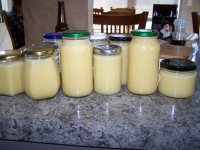My first extraction of honey, 6 weeks ago, has gone from runny to quite a thick consistency, even in this heat, sitting in its bucket. I noticed that a jar of it I was using a few weeks ago, was starting to look like it was going 'creamed'. Which I was quite happy about, as I want to cream some anyway and was thinking I would need to buy a starter. So I put that jar away.
I have just checked that jar today, and it has set well, it now appears to be creamed honey, which I am pleased about!
My question is, is there a reason that it has done this by itself? I realise that honey does cyrstalise, but this has been quite fast and in warm weather... Is it the content, eg clover or such like, which is more prone to going that way.
I have just checked that jar today, and it has set well, it now appears to be creamed honey, which I am pleased about!
My question is, is there a reason that it has done this by itself? I realise that honey does cyrstalise, but this has been quite fast and in warm weather... Is it the content, eg clover or such like, which is more prone to going that way.



